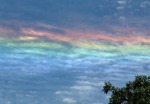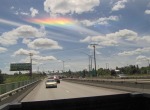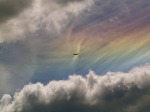Have you ever heard of a “fire rainbow”? Well, it’s neither fire nor is it a rainbow.
These rarely appearing so-called “fire rainbows” have a brilliant pastel-colored flame-like appearance but are actually known as circumhorizontal arcs–ice halos formed by hexagonal, plate-shaped ice crystals in high level cirrus clouds. When these arcs are large enough, they appear parallel to the horizon.
Why are they so rare?
These “fire rainbows” occur mostly during the summer and between particular latitudes. When the sun is very high in the sky, the sunlight enters flat, hexagon shaped ice crystals and the light gets split into individual colors–just like what happens when light runs through a prism. The conditions required to create a fire rainbow has to be very precise: The sun has to be at an elevation of 58 degrees or greater, there must be high altitude cirrus clouds with plate-shaped ice crystals, and sunlight has to enter the ice crystals at a specific angle.
But that’s not all. The position of the viewer is just as important. Fire rainbows cannot be seen in locations north of 55 degrees or South of 55 degrees. And there are certain times of the year when they are visible. For example, if you live in Los Angeles, the sun is higher than 58 degrees for 670 hours between late March and late September.
Iridescent clouds can also create a similar effect. While circumhorizontal arcs occur only in cirrus clouds, iridescence often occur in altocumulus, cirrocumuls and lenticular clouds but rarely in cirrus clouds.










